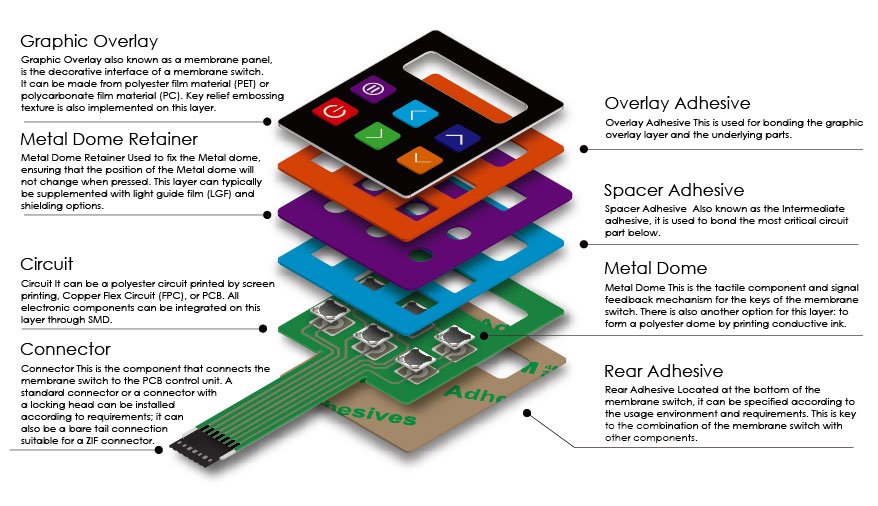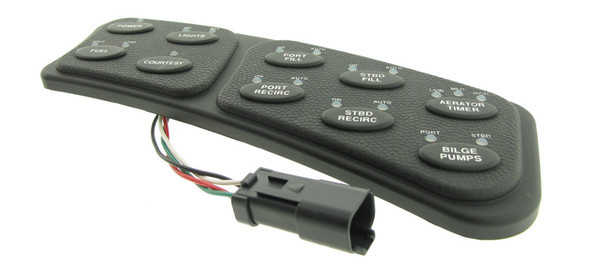The Manufacturing Refine Behind Membrane Layer Switch Over: What You Required to Know
The production procedure behind membrane switches over combines mindful style, product selection, and top quality control. It starts with recognizing the complexities of membrane button layout and proceeds through numerous stages, consisting of material selections and printing techniques. Each phase plays an important duty in making certain capability and sturdiness. Nevertheless, the intricacies of layer building and construction and the strenuous testing standards might reveal understandings that are not right away noticeable. What exists past these foundational elements?
Understanding Membrane Layer Switch Design
Membrane buttons may appear easy at very first look, their design entails detailed factors to consider that assure capability and toughness. The layout process starts with a complete understanding of individual needs, consisting of the user interface's desired application and ecological variables. Comfort designs is a crucial element, as the layout has to facilitate convenience of usage while making certain that responsive responses meets customer expectations.Moreover, the layering of components, such as graphic overlays, glue layers, and conductive traces, have to be specifically crafted. membrane switch. This split arrangement not just affects the switch's responsiveness however likewise influences its long life. Interest is provided to the securing strategies employed to safeguard against wetness and dust, which can jeopardize efficiency. In addition, style factors to consider expand to aesthetic appeals, where color design and aesthetic quality boost customer experience. Inevitably, the layout of membrane switches over balances capability, individual experience, and toughness, ensuring that they meet the demands of various applications successfully
Materials Made Use Of in Membrane Switch Over Manufacturing
When picking products for membrane switch production, it is important to contemplate both performance and sturdiness. The main materials include polyester and polycarbonate films, which supply adaptability and toughness. These movies are often coated with glue to assure proper bonding to substratums. Conductive inks, normally made up of silver or carbon, are critical for creating electrical links within the button, permitting for dependable operation.Additionally, a protective layer, such as a hard coat, is often put on improve scrape resistance and long life. The option of backing product, such as acrylic or foam, can substantially impact the button's tactile feeling and overall customer experience. Various ecological elements, including temperature level and moisture, ought to direct product choice to guarantee peak performance in certain applications. Eventually, the best combination of materials contributes to the membrane button's capability and life expectancy, making educated options important for suppliers.
The Printing Process: Creating Graphics and Text
The printing process in membrane switch manufacturing plays a substantial duty in producing high-quality graphics and message. Numerous graphic style techniques are employed to guarantee visual appeal and performance, while mindful ink choice approaches are vital for resilience and performance. Comprehending these components is essential for accomplishing best results in membrane switch style.
Graphic Layout Techniques
Graphic design strategies play a vital role in the printing procedure of membrane layer switches, as they specify exactly how graphics and text will inevitably show up on the end product. Reliable visuals design involves the critical use designs, colors, and typefaces to enhance readability and visual charm. Developers often use vector graphics for scalability, guaranteeing that images continue to be sharp at various dimensions. In addition, interest to comparison and placement is crucial, as it influences individual interaction and visual quality. The unification of branding aspects, such as logo designs, need to be handled with like preserve brand honesty. Overall, thoughtful graphic layout methods contribute substantially to the functionality and beauty of membrane switches, influencing user experience and product performance.
Ink Choice Techniques
Choosing the appropriate ink is necessary for attaining the preferred visual high quality and toughness in membrane layer switch production. Numerous ink kinds are used, including solvent-based, water-based, and UV-curable inks. Each type uses unique features, such as resistance, attachment, and versatility to ecological elements. Solvent-based inks are usually favored for their sturdiness and dynamic shades, while water-based inks are more environmentally pleasant however may have constraints in adhesion. UV-curable inks offer quick healing and robust performance. Furthermore, shade matching methods guarantee that the selected inks align with layout specifications. Ultimately, the option of ink should consider elements such as application approach, substratum compatibility, and end-use requirements to accomplish premium lead to membrane layer button graphics and message.
Layer Building And Construction and Assembly

Product Option Refine
A careful selection of products is necessary in the production process of membrane buttons, as it directly influences performance and resilience. The key materials utilized consist of polyester, polycarbonate, and various conductive inks. Polyester is usually favored for its excellent resistance to chemicals and abrasion, making it ideal for harsh environments. Polycarbonate, on the other hand, gives remarkable clearness and impact resistance, which is advantageous for applications requiring exposure and toughness. Conductive inks, commonly made up of silver or carbon, are essential for producing trustworthy electric pathways. In addition, the option of adhesive materials influences the total honesty of the switch - membrane switch. Assessing variables such as ecological exposure, responsive comments, and aesthetic demands overviews suppliers in picking the very best materials for their particular applications
Layer Bond Methods
Adhering layers in membrane switch building is a crucial procedure that ensures performance and long life. Different bond techniques are used to protect optimal bonding in between layers, which commonly consist of the use of adhesives, warm, and pressure. Pressure-sensitive adhesives (PSAs) are typically used for their simplicity of application and prompt bonding capacities. Additionally, thermal bonding methods can be applied, where warm is made use of to activate sticky properties, safeguarding a solid bond. The choice of bond technique mainly relies on the materials entailed and the details application requirements of the membrane button. Proper alignment and consistent application of adhesives are important to avoid issues, safeguarding the button runs successfully throughout its designated lifespan.
High Quality Control Steps
Guaranteeing top quality control during the layer building and construction and setting up of membrane switches is important for maintaining performance and dependability. This process normally involves several crucial steps, including thorough inspections at each phase of manufacturing. Suppliers use sophisticated screening techniques, such as peel tests and attachment evaluations, to confirm the honesty of layer bonds. Furthermore, visual examinations are carried out to determine any type of flaws in printing or product incongruities. Environmental conditions, such as temperature and moisture, are very carefully monitored to assure optimal curing and attachment. Routine calibration of equipment helps preserve exact production standards. By implementing these quality assurance measures, suppliers can considerably minimize the risk of item failure, ensuring that the final membrane layer switches over meet the needed specifications and client assumptions.
Evaluating and Top Quality Control Actions

Technologies in Membrane Layer Switch Over Technology
As advancements in modern technology continue to develop, membrane buttons are taking advantage of innovative developments that enhance their performance and customer experience. One remarkable technology is the integration of capacitive touch technology, which permits even more intuitive and receptive user interfaces. This shift not just boosts appearances yet also decreases mechanical deterioration, prolonging the life-span of the switches.Additionally, advancements in visuals overlay materials have brought about improved toughness and resistance to ecological aspects such as dampness and UV light. These materials now provide improved quality and illumination, more raising the aesthetic appeal.Furthermore, the consolidation of wise technology is changing membrane changes right into interactive control panels, enabling connectivity with IoT tools. This connection fosters a smooth individual experience, leading the way for applications in different industries, from medical care to customer electronic devices. Collectively, these developments placement membrane switches over as essential components in modern gadget layout.
Frequently Asked Questions
How much time Does the Membrane Layer Switch Manufacturing Process Take?
The duration of the membrane layer switch production process can vary substantially. Variables such as complexity, products used, and production quantity impact timelines, with common production ranging from a couple of days to a number of weeks for conclusion.
What Are the Usual Applications for Membrane Layer Buttons?
Membrane layer switches are generally utilized in numerous industries, including auto controls, house home appliances, medical devices, and customer electronics (membrane switch). Their adaptability and durability make them ideal for applications needing user-friendly user interfaces and trusted performance in varied environments
Can Membrane Layer Switches Over Be Customized for Certain Needs?

What Is the Life-span of a Common Membrane Switch Over?
The life expectancy of a regular membrane switch varies, yet generally, it varies from 1 to 5 million cycles. Variables such as usage, environment, and worldly top quality considerably affect durability and total efficiency over time.

Are Membrane Switches Over Eco-friendly?
The environmental friendliness of membrane switches over differs. Some materials made use of might not be recyclable, while others can be environment-friendly. The overall impact depends on making materials and methods, requiring mindful factor to consider during why not try here option and disposal. The production procedure behind membrane layer switches combines careful layout, material selection, and top quality control. It starts with comprehending the complexities of membrane button layout and proceeds through numerous stages, consisting of material options and printing strategies. When selecting products for membrane switch production, it is important to contemplate both performance and longevity. A cautious option of products is important in the manufacturing process of membrane layer switches, as it directly influences capability and sturdiness. The option of attachment technique greatly depends on the materials included and the specific application demands of the membrane the original source layer switch.